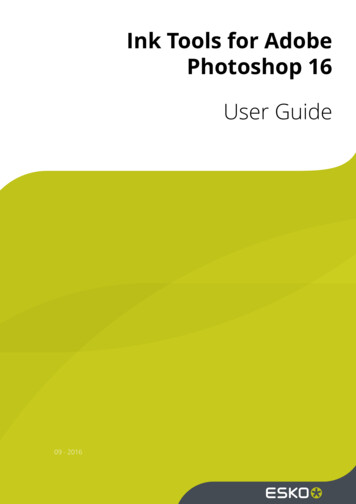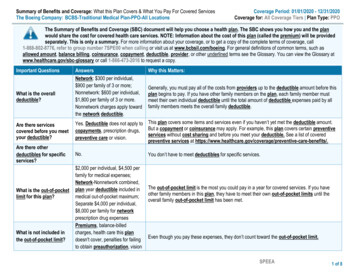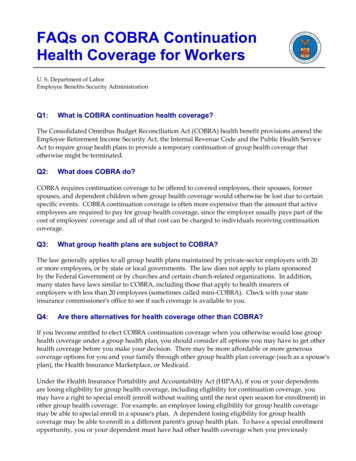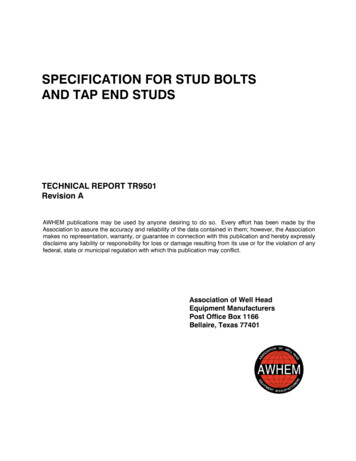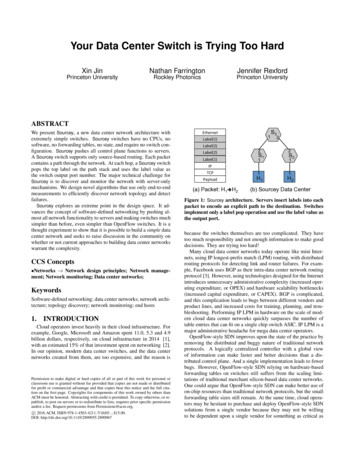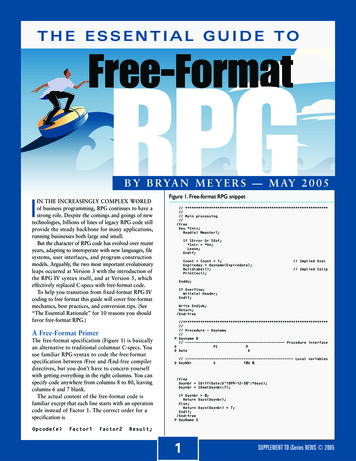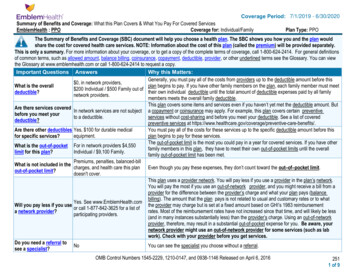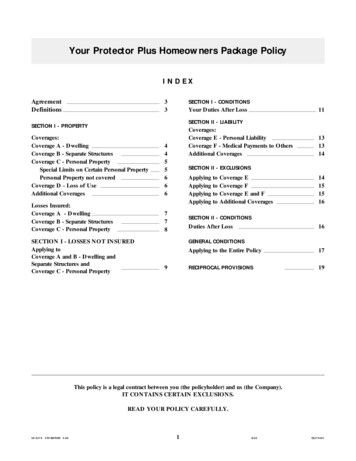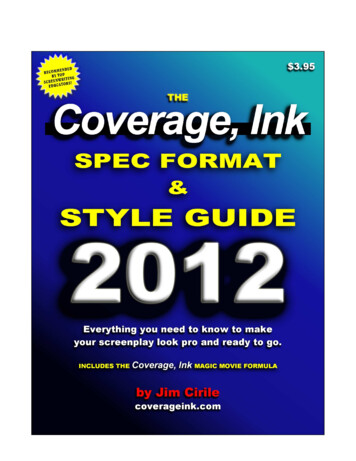
Transcription
1
The Coverage Ink Spec Format & Style Guide 2012 Editionby Jim CirileCopyright 2012, Coverage, InkWelcome! If you’re considering writing a screenplay, or perhaps you’ve written a fewscreenplays but are still unsure as to exactly what they are supposed to look like, or evenif you’ve written a whole big pile of screenplays and think you know everything -you’ve come to the right place.Screenplay format is a deceptively difficult thing to master. It looks so easy, even perhapsintuitive, as you read a script, doesn’t it? Sure, the guy talking is in the middle, and thenthe other stuff is over at the left side piece o’ cake.But as you sit down to write one yourself, that’s when the headache begins. Whereexactly does the dialogue go? Is it centered? Am I supposed to tell the camera what todo? What words get CAPITALIZED? How do I tell the audience that this line issupposed to be sarcastic and said with a wink? And on and on.Well, fear not! We’re here to help you master screenplay format. And we’re going to doit in a breezy, accessible style, because learning this stuff should be fun, not an exercisein tedium. Relieved? Good. I know we are.Just remember, we at CI are here to help. Feel free to e-mail us with any question atinfo@coverageink.com.Onward!2
INDEXp. 5GETTING STARTEDThe part we all dread! As Douglas Adams once said, “I don’t enjoy writing nearly asmuch as having written.” This section will cover:p. 5p. 6p. 7p. 9p. 10p. 12Seriously, Do I Need to Use Correct Screenplay Format?Where to Find Scripts (and Why You Should Read Them)What Paper Should I Use? (and Is Paper Obsolete?)Do I Need to Use Covers?How Do I Bind This Script Thing?Screenplay Format Terminologyp. 12p. 12p. 12p. 14p. 15p. 17p. 17p. 20p. 22p. 24p. 24p. 27INT/EXTFADE IN/OUTSHOT CALLS, CAMERA CALLS & MUSIC CALLSV.O. vs. O.S.ParentheticalDirection/ActionTransitionsSlug LinesIntercutAct BreaksSoftwareWRITE IT!The meat in this two-fisted burrito. Ready to get writin’? Wait—don’t you have toprocrastinate a little longer first—check your e-mail for the 90th time, scrub out the toilet?p. 28p. 32p. 35p. 37p. 38p. 40p. 41p. 43p. 44p. 46p. 49p. 52p. 53p. 55p. 55p. 56p. 58p. 59Margins, Spacing and FontWhite on the PageTitle PageLocationsContinuous & LaterDescriptionCharacter IntroductionsShooting Script Versus Spec ScriptDialogue (and Dual Dialogue)CAPITALIZING, Bold, Italics and UnderliningEllipsis ( ) and Dashes (--) and Periods, Oh, My!SubtitlesMontages & Series of ShotsFlashbacks & Dream/Fantasy SequencesPauses (Beats)Writing Down the PageSingle or Double-Sided?Length3
p. 61ADVANCED STUFF – READ AT YOURYOUR OWN PERIL!Just kidding. But here are a tips and techniques you can employ to make sure your scriptrocks the proverbial house.p. 61 Proofing, Editing and Spell-Checkingp. 66 Common Grammatical (and other) Mistakesp. 70 Widows & Orphansp. 71 Final Draft tricks (Dude, Where’s the @%!(&% &!! Title Page?)p. 73 How to Make a PDF in Movie Magic Screenwriterp. 73 Character Counts!p. 74 Character Name Consistencyp. 76 The Coverage, Ink Magic Movie Formulap. 78 Inserts, Enclosures and Diagramsp. 79EXERCISESEXERCISESOnce you have your sea legs, we’re going to let you take a couple practice runs. We’llgive you some text. Your job will be to put that text in proper screenplay format.p. 81p. 83ResourcesSample Screenplay Opening***Ready to take the plunge and learn all about screenplay format and style? All right!Fasten your seatbelts, strap yourselves in, hold on tight (and any other hyperbolic clichésyou might want to use here,) and let’s go!Just remember, none of this is rocket science and none of it is absolute. People breakthese ‘rules’ all the time. Ultimately it’s all about, what’s the best way to get your storyacross? If you ever get stuck or can’t figure out how to write something, don’t be afraidto shoot an e-mail over to info@coverageink.com and ask us anything! We were rated“Cream of the Crop” in a 2010 Creative Screenwriting user survey and we really do goout of our way to help people. Holla!4
GETTING STARTEDSERIOUSLY, DO I NEED TO USE CORRECT SCREENPLAY FORMAT?Oh, so you think this is a trick question, huh? The answer is yes and no. Didn’t see thatone coming, did you?It’s all about who you are and what you bring to the table. There are writers out therewho have careers precisely because they eschewed all the rules of screenplay format.Take Larry Ferguson (The Presidio, The Hunt for Red October) for example:“If I don’t want to write this INT./EXT, can I invent my own form?,” Ferguson recallsthinking. “Because I thought that when I read the INT./EXT., PULL BACK TOREVEAL, etc., I thought that was telling me a lot more about the writer’s familiarity withthe medium than it was about the story. I want to just close my eyes and say, ‘What doyou see on the screen?’ So I started writing that way. I didn’t put locations into my shots.I just jumped from one visual image to another. There weren’t a lot of people writing thatway, and I was doing myself a service without knowing it.”So Ferguson pioneered his own style, and his career took off like a rocket. Of course, hehad terrific storytelling skills to boot, and the chutzpah to barge into top literary agentBen Benjamin’s office and demand Benjamin read his screenplay. “Two and a half weekslater, he called me and told me he liked my work,” laughs Ferguson. “He wasn’t sure ifhe liked me very much, and his actual words were that I had ‘balls that clank.’”But now let’s look at you and me and reality. For most of us the answer is YES, you doneed to know how to format your screenplay. Because even if you’re the most amazingstoryteller on the planet, if your script doesn’t look like a script, overworked creativeexecs will open your script, groan, and think, “amateur hour.” And just like that, you’redead in the water. For every 25 people who might read your screenplay, there might beone who is an intrepid, forest-for-the-trees type who won’t simply scoff at yourimproperly formatted script and then line his cat box with it.So bear in mind the next time you read a script by a big-name writer and you noticethings like—“Jeez, this thing has 12 typos on page one!,” and “This guy never used ANYpunctuation in the entire script – it’s just one big run-on sentence!” (and believe me,those guys are out there, and they’re making big bucks)—you may or may not have toadhere to all of these persnickety guidelines we’re about to lay on you. It will be up toyou to decide how much, if at all, you want to push the envelope.But know this well: no one ever passed on a script because it was well-formatted.5
WHERE TO FIND SCRIPTS (AND WHY YOU SHOULD READ THEM)So you’ve got an idea you think would make a cool movie. That’s great! Now how doyou actually get it down on the page? And what do movie and TV scripts even look like?Before you do anything else, you need to read some scripts. You wouldn’t try to designan airliner without ever having flown in one, right? Same thing with a movie script. Youcan’t learn screenplay format without ever having seen a screenplay. And yet somewriters do exactly that.There are plenty of places to get scripts. One good place you should look is Drew’sScript-O-Rama (www.script-o-rama.com.) This site offers hundreds of scripts, FREE todownload. Now you can’t beat that deal. Most of these are in their original formats.Chances are good they have your favorite movie scripts there—and sometimes evenseveral versions of the same movie! Read them and pay careful attention to how theylook, how they flow on the page. Screentalk (www.screentalk.biz) also has a goodselection of scripts for free.There are other websites that offer scripts for download, but since they are not free, weare not going to plug them here.If you live in Los Angeles, you will find tons of scripts available at the WGA and MPAAlibraries and reading rooms. Additionally, most colleges with film or screenwritingprograms have scripts. The UCLA library is excellent.One place you do not want to look for scripts, however, is your local bookstore.Sometimes screenplay format gets butchered when a script is published in book form. Ifyou try emulating the screenplay format from, say, your “Four Screenplays by WoodyAllen” paperback, you’ll be shooting yourself in the foot.Lastly, if you have any industry friends, chances are good they’ll be able to get youscripts. These do not have to be scripts from produced movies—any screenplay writtenby a writer currently working in the business should be a worthwhile read.Once you’ve read a few of these, you’ll start to get the feel of it. What do they all have incommon? And what do they do differently? In the world of screenplay format, there is noone standard paradigm—a Quentin Tarantino script looks completely different from aSusannah Grant script. Yet they all (more or less) follow the same basic rules.6
PAPERScreenplays are generally printed on plain old generic copy paper. If you really need thedetails, we’re talking the 20 lb. “premium white copy paper” you can find at any officesupply store. For extra credit, try to buy paper with a brightness rating of 80 or above.This means that the paper has been bleached to a high degree of whiteness (sorry, Earth.)Paper with a low brightness rating can look a bit dingy, dull and grey, and this can subtlycreate a negative first impression. Office Depot has a terrific, cheap 20 lb. copy paperthat’s rated 104 in brightness. That’s perfect.Some writers make the mistake of using heavier weight paper—24 lb. stock or evensometimes textured, resume-type paper—thinking this will make their script look moreprofessional. But guess what happens when you use heavier stock? Your script getsnoticeably THICKER. Which is definitely something you do NOT want.First impressions are everything. When a creative executive sits down to read a pile ofscripts, he’s going to pick the one on the pile that looks the easiest to read first. Now ifyour script is a quarter inch thicker than all the others on the pile—even if all the scriptsare 110 pages—he’ll get to yours last, if at all. So when it comes to paper, cheaper isoften best.Is Paper Obsolete?The short answer is: pretty much so, yeah. Most companies nowadays prefer you tosubmit an Adobe PDF (electronic copy) via e-mail. The reasons for this are many. It’smore environmentally friendly (less trees being destroyed, less fuel used to deliver thescripts to the companies); it saves on postage. Most screenwriting programs allow you tosave your script as a PDF, which can be read with Adobe Acrobat Reader (a freedownload from www.adobe.com.) If you’re still using MS Word to write screenplays(NOT recommended, but we’ll get into that later,) you can still make a PDF of yourscreenplay for free by going to www.PDFonline.com. You upload your Word doc, andthey email you back the screenplay as a PDF. It’s a beautiful thing.In the early days of e-mail, some writers refused to submit files electronically, fearing thescripts could easily be ripped off. But with the advent of PDF, those security concerns arenot quite as concerning. Since a PDF is a snapshot of each page, the data on it cannoteasily be manipulated or cut and pasted into another script file. It can be done, but wouldrequire painstaking line-by-line reformatting, and who the heck wants to go to all thattrouble? If someone is going to plagiarize something, they’ll do it because it’s easy, not apain in the rump.While it may actually cost the company a bit more than getting hard copy submissions, asthey do have to print the script out—some may perhaps only print the first ten pages andthen decide whether to print the rest if they like the opening. Or they may simply read abit of it on the monitor before deciding whether to print it at all. I know some guys whoonly read on the monitor, thus saving their companies dough. And lastly, the big agencies7
and prodcos used to do everything by messenger. Big spec going out? That’s a significantexpense. But now, instantaneous free delivery—you can’t beat that.All of which makes the discussion of what paper to use above probably pretty moot.Paper, by and large, is a non-issue.8
DO I NEED TO USE COVERS?If you’re still submitting printed script copies via snail mail, well, in a word, yes. First ofall, they hold your script together. What happens when you bind a script with brads anddo not use covers? About halfway through the read, the first page falls off. By the timeyou’ve finished the read, several pages have come off, and the ones that remain tend toget dog-eared and dirty.Get yourself some decent card stock. You can buy a ream of it at any office supply store.You want to get the 60 lb. stock—firm but not TOO firm. If you use a card stock that’stoo thick, they’ll be hard to bend, which will make the read annoying.You can use any color you want. It matters not. But beware using fancy card stock withborders or designs or textures. This sort of thing screams “Unprofessional!” Plain oldblack or white medium weight card stock is the ticket.By the way, in your travels you may come across a screenplay with agency covers. Sureis tempting to take those CAA covers off that script and put it on yours, isn’t it? Yep.That’s fine for make-believe play, but don’t make any industry submissions that way!Sure, you’ll certainly make a much better first impression. But when the person you sentthe script to calls to check—and they WILL—you will find that door whacking you onthe butt on the way out.9
HOW DO I BIND THIS SCRIPT THING?We’ve seen it all. On one end of the spectrum, we’ve seen 120 pages held together with apotato chip clip. On the other end, we’ve seen scripts (expensively) hot-melt-bound like apaperback book. Both of those say “amateur.”If you’ve ever seen a script from an agency or a production company, you’ve probablynoticed, “Hey, wait a minute—this thing is simply 3-hole punched and bound withcommon brass brads.” That’s right—industry standard is to bind a script with TWO (notthree) brads—one in the top hole, and one in the bottom hole. The center hole is to be leftEMPTY. Why? Nobody knows. It just is. May the Lord take pity on the poor soul whoputs a third brad in the center hole! Again, this says “amateur.” And again, nobodyexactly knows why. Conspiracy theorists, have at it.Here’s how to do it:1) Print out your script (on the aforementioned cheapo copy paper.)2) 3-hole punch your paper and covers.3) Bind your script with two brads.Whew! Rocket science, huh? Okay, there is a bit more to it. Firstly, you need to use THERIGHT KIND OF BRADS.This is critically important. Brace yourself: we are about to impart unto you the biggest,best-kept secret in the world of screenwriting. Ready? Here it is:USE ONLY ACCO BRAND 1 ½-INCH SOLID BRASS BRADS (#6.)Do NOT use office superstore brads!The reason? Those superstore brads are not real brass. They hold your script togetherabout as well as crumpled aluminum foil. Halfway through the read, the script will selfdestruct in a miasma of scattered pages all over the floor. And nothing irks a creativeexec more than when he has to pull out your cheapo Staples-brand brads and replacethem with his own Acco brads just so he can read the darn script.And no, Acco has not paid us one dime for this endorsement. Their product is simply thebest. Bear in mind you cannot buy these at office superstores, because they want you tobuy their cheapo brand instead. You’ll need to get them from www.writersstore.com, alocal mom n’ pop STATIONERY store, or else do a web search for Acco Brass Brads.They come in a box of 100 for about 8 bucks.Other kinds of binding such as report folders, binding machine binding, etc., all say you guessed it—“amateur.” So do yourself a big favor and get some Acco.10
Note that some folks like to use binding screws—little silver screws that fit perfectly intothe holes and twisty down nice and flat with no sharp edges. Those are perfectlyacceptable, too.But again, see the previous section about paper being obsolete 11
SCREENPLAY FORMAT TERMINOLOGYThis is the part where many newbies find themselves lost. There are a lot of terms inscreenplays that many folks will be unfamiliar with. So we are going to break ‘em downfor you right here.INT. and EXT.Short for INTERIOR and EXTERIOR. Used in Location slug lines. (See Slug Lines,below.) This tells the reader whether the scene takes place inside or outside. Example:INT. JONAH’S TRAILER – NIGHTFADE IN and FADE OUTUsed at the beginning and the end of the screenplay (often regardless of whether or notthere really is a fade in or fade out.) It’s sort of a shorthand to tell people the script isbeginning (duh) and the script is now over (duh again.) Can also be used in the body ofthe script for emotional moments or to show a passage of time.Word of warning: don’t NOT use these simply because you do not think you need them,or you don’t see your movie starting with a fade in. That’s one of those idiotic things youget snap-judged on. So unless it’s very important that you start on a certain image or overblack, make sure to use FADE IN: at the beginning of your screenplay and FADE OUTat the end.SHOT CALLS, CAMERA CALLS, MUSIC CALLSRED ALERT!!!!Never, ever use shot calls, camera calls or music calls.These things are the director’s purview—not yours.A shot call, or camera call, is when someone tells the camera, or the director, what to doin the script, such as:CLOSE UP on Peter, unscrewing the bottle of soda.In virtually ALL cases, these are to be avoided like the plague. Why? Because it is notthe writer’s job to tell the director where to place the camera. Directors consider this aninsult, and worse, if you use camera calls in your script, industry types who read it willthink—you guessed it—“amateur.”12
In most cases, you can simply write the action without the camera calls, and the directorwill somehow figure out how to shoot it properly:Peter unscrews the bottle of soda.If for some reason it is absolutely necessary to direct the camera—for example, maybePeter is critically injured, and we need to see his facial expression as he desperately triesto open the soda so as to cling to the last scraps of his humanity, you can indicate whatthe camera sees using a SLUG LINE:PETERUnscrews the bottle of soda.More about slug lines below.Now there are a few camera directions that are okay to use if employed sparingly:CLOSE ON (or TIGHT ON,) WIDE and PULL BACK TO REVEAL.CLOSE ON is for the most part unnecessary, because instead of saying:CLOSE ON PETER, nervously picking his fingernails andbouncing on his toes.We can use a slug line (again, more on this to come) to do the same thing, like so:PETERNervously picks his fingernails and bounceson his toes.Pretty obvious we’re close on Peter, right?And none other than William Goldman loves his PULL BACK TO REVEALS, becausethey are in fact a very effective way of telling the reader we weren’t seeing the wholepicture at first, but now we are, and ha!, there’s a surprise there you didn’t expect. Feelfree to use this, even though technically it is a camera direction. It’s a fun little trick.MUSIC CALLS are much the same animal as camera calls –to be avoided like theproverbial plague. For instance, let’s say you write:VAN HALEN’S “JUMP” plays on the stereo as Brian dropshis dentures into a glass.Fine, but have you thought about the film’s BUDGET? What if Van Halen wants 1million just to use a 10-second clip of “Jump” in the movie? Music licensing is13
notoriously expensive, particularly from well-known artists. There’s a reason “Stairwayto Heaven” was not used in “Almost Famous.”So don’t even think about putting Sinatra, Led Zeppelin, Green Day, whatever, on theradio in your script. Instead, refer to a Sinatra song like this:On the radio, a crooner belts a TUNE in classic RatPack style.Or to your Van Halen tune like this:A jumpin’ classic ROCK SONG plays on the jukebox.And let the music supervisor worry about plugging in the songs later. If the script getsproduced, you can always tell the director, “Hey, I always envisioned Pink Floyd’s“Careful With That Axe, Eugene” would be playing throughout the murder scene. Anychance we can license it?”O.S. VERSUS V.O.O.S. stands for OFF SCREEN. V.O. stands for VOICEOVER.When a character speaks, but we can’t see him in the shot, he is considered off-screen, orO.S. So you would indicate that like this:BILL (O.S.)Three-quarters dead, that dog justkept right on goin.’Note that the O.S. (and V.O.) goes in parenthesis to the RIGHT of the speaker’s name(Bill.) It does not go UNDER the person’s name like this:(WRONG)BILL(O.S.)Three quarters dead, that dog justkept right on goin’.The space under the speaker’s name is reserved for parenthetical, or line-readingdirection. More on that in a moment.V.O., or VOICEOVER, is ONLY used when a character is narrating from off-screen—for example, Deckard’s much-reviled voiceover segments from “Blade Runner.” LikeO.S., the V.O. designator goes to the right of the speaker’s name.14
DECKARD (V.O.)Boy, that replicant was a hottie! ButI can’t let myself be distracted frommy, uh, mission. whatever that was.V.O. can also be used when a character is narrating a scene that he or she is in andcommenting on it, such as in the TV show My Name Is Earl.PARENTHETICALParenthetical means the line-reading cues which are placed under the speaker’s name andabove the dialogue. It should be used to indicate to whom a character is speaking, if it’snot already obvious, OR occasionally, to add a new dimension to the line reading notclear from the line itself. Example:LEON(to reporters)I tried to make him fight my fight,but he made me fight his fight.Leon abruptly keels over.Note the placement: The speaker’s name is indented the most—just about center of thepage, or five tabs over in MS Word. Parenthetical direction is indented from the dialogue,but not as far over as the speaker—four tabs in MS Word. And then the dialogue marginis the farthest left, except for the DIRECTION (Leon abruptly keels over.) More ondirection below.These can also be used mid-dialogue to indicate a pause (beat) or to clarify who thecharacter is now addressing, e.g.:BOSKOBut, Ms. Finglebloon, I didn’tdrink the spinach water!(beat)I have green all around my mouth,don’t I?Don’t forget to indent and to ‘hard return’ before and after using parentheticals! We’veseen this before:15
(WRONG)MILDREDBut, Ma, all the kids in firstgrade have iPhones. (to Dad) Firstgraders without iPhones suck!That’s just messy and hard to read. The parenthetical should be on its own line, nothingelse on it.RED ALERT!!!!DO NOT OVERUSE PARENTHETICAL DIRECTION! Doing so will make yourscript scream you guessed it “Amateur!” Nothing is worse than opening a scriptand seeing parentheticals above every single line of dialogue.In general, people will be able to figure out what you were getting at simply from the line.There’s seldom a reason to embellish further. Let the actors act. Trust us, they will add allthe necessary arm gestures and head gyrations. That’s what they’re paid to do.However, if the movement is short, character-centric and dramatically necessary, thensure, go ahead:LEON(rolls his eyes)Oh, yeah, I made him fightmy fight.The parenthetical direction here tells us that Leon is being sarcastic. We might havefigured that out just from the line, the setting and Leon’s demeanor, but we might nothave. So add a little eye roll, and the meaning is clear.Another important parenthetical rule: never use parenthetical for MOVEMENT CUES,like this:(WRONG)LEON(steps over to the water coolerand takes a big gulp, thenburps loudly; smiles toothlessly)I tried to make him fight my fight,but he made me fight his fight.16
What’s happening here is that we’re directing the action, or the movement, within theparenthetical. But movement direction actually goes flush left. Again, parentheticaldirection is only for line-reading cues or to show to whom a character is speaking. Thecorrect way to do the above example:Leon steps over to the water cooler and takes a biggulp, then burps loudly. He smiles toothlessly.LEONI tried to make him fight my fight,but he made me fight his fight.DIRECTIONNo, this isn’t what men have a hard time asking for when lost (thanks God for GPS!)When it comes to screenplay format, Direction means anything at all that tells the readerwhat’s going on in the story. It is placed at the far left border of the page, and stretches allthe way across the page, like this:INT. WAREHOUSE – NIGHTDark and silent. Suddenly: CLANK of a padlock beingsmashed open. Loading bay door rolls up, andFLASHLIGHTS pierce the blackness.TWO MEN IN CHICKEN MASKS AND PINK TUTUS swish into theroom.Simple, right? Yep.TRANSITIONSA tricky-sounding word that just means how you get from one scene to another. Theseinclude CUT TO:, DISSOLVE TO:, MATCH CUT TO:. FADE IN and FADE OUT, andour favorite—SMASH CUT TO: or SLAM CUT TO:These are placed three quarters of the way across the page—not quite all the way to thefar right border, but close to it. If you use screenwriting software like Final Draft orMovie Magic Screenwriter, they place the transitions in the proper place for you. Just oneof the numerous advantages of using those programs!Here’s an idea of what a transition looks like:17
LEON(to Reporters)You’ll see. He thinks he gonnamake me fight his fight. Buttonight, I’m making him fightmy fight.SMASH CUT TO:INT. BOXING RING – NIGHTLEON’S FACESLAMS against the mat in a spray of blood,spittle and teeth.See how we’ve used the SMASH CUT TO: to emphasize the gag? We go from Leontelling everyone he’s going to dominate—then SMASH CUT right to the ring, where it’sclear it just isn’t Leon’s night. We also use a SLUG LINE (see below) to tell us we’retight on Leon as he hits the mat. In other words, we’ve told the camera what to shootwithout actually saying, “CLOSE UP ON LEON.”Note however, that that particular joke—saying one thing and then immediately doing theother—is so overused as to be INCREDIBLY LAME. Don’t actually do that in yourscript. You’re more creative than that.One question that comes up a lot is “Should I use CUT TO: between scenes?” Theanswer is: maybe!Many screenwriters simply don’t bother with CUT TO: anymore because frankly, youjust don’t need them. It’s obvious from the new Location Slug that we’re in a new scene;we don’t need a CUT TO: to tell us we’re about to go there. It’s like saying, “get ready,I’m about to make a turn,” every time you drive. Just make the darn turn.However, some writers still use CUT TO:, and that’s perfectly valid. Just make sure thatyou only use it at the end of a SCENE UNIT, not after each and every shot in a sequence.A scene unit is either a single scene or a cluster of scenes that are all related and part ofthe same sequence of events. Otherwise you will have a lot of CUT TOs cluttering upyour script.However, don’t be afraid to use SMASH CUT TO: or other effects as dramaticallynecessary. If you feel it helps the emotion or theme of your script to DISSOLVE rainstriking a puddle to the tears rolling down a distraught mother’s face, by all means do it.18
MATCH CUTS & DISSOLVESEvery now and again, you may wish to employ a match cut. This is a fancy-shmancy wayof saying you’re cutting from one image to another one that looks similar to it. This canbe used for humorous effect, or simple to be cool. Mostly this is a director thing – thedirector will figure out how to shoot the movie – but when employed by the writer, it canshow you’ve got visual style.To use a match cut, just use it as a slug line, like so:MATTHEWPicks his nose, dumbfounded.MATCH CUT TO:GORDO THE GORILLAIn the exact same pose.Pull back to reveal:EXT. SAN DIEGO ZOO – GORILLA HABITAT – CONTINUOUSThrongs of people watch Gordo play with his booger.A dissolve is just another kind of transition. It cross-fades from one image to another.You generally don’t need to worry about transitions like this, since those are directorial(and editorial decisions.) But occasionally for storytelling reasons you may wish toindicate a dissolve in your screenplay. There are two ways to do this. The first is to usethe ‘transitions’ column on the page, which is way over on the right hand side of thepage, like so:DISSOLVE TO:All well and good, except that oftentimes people miss these cues because they’re farright. They tend to get ignored, glossed over. So with all transitions, if it’s superimportant, you can just put it in a slug line on the left side, like this:DISSOLVE TO:Where no one will miss it. But again, don’t do this unless it is critical to the storytellingand accomplishes a specific purpose by being there.19
SLUG LINESSlug Lines are one of the most useful tools in a writer’s arsenal. They serve manyfunctions. They can tell us where we are; they can call attention to a certain character oroccurrence or indicate a camera call without ever using the word “camera”; they are amore VISUAL way to write, and film is of course a visual medium; and best of all, theybreak up the action and add WHITE to the page. We’ll get into the concept of “White onthe Page” in a little while. Just about anything you need to do in a screenplay can andshould be done with a slug line.Now let’s look at two examples. Except for the location slug (which always begins ascene and starts with INT. or EXT.,) Example A does not use slug lines.A)EXT. MOUNTAIN ROAD – DAYTito guns the Jeep across the icy mountain road whensuddenly a school bus full of kids appears out ofnowhere! Tito slams on the brakes, and the Jeep skidsout! Kids in the bus SCREAM as the bus comes withininches of hitting the Jeep, and Tito just missesthem, sighs in relief –- then gasps as the Jeep skidsoff the road and down a ravine! CRASH! Tito’s airbaginflates as the Jeeps slams into an old spruce tree,then flips over –- and suddenly Tito’s door opens andhe falls 25 feet to the ground!Yecch, that was pretty bad. It’s a bi
Sometimes screenplay format gets butchered when a script is published in book form. If you try emulating the screenplay format from, say, your “Four Screenplays by Woody Allen” paperback, you’ll be shooting yourself in the foot. Lastly, if you have any industry frie
